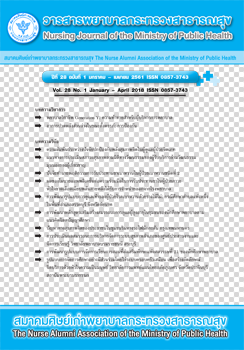Development of a Pedagogical Model to Promote 21st Century Skills of Nursing Students
Main Article Content
Abstract
This research and development study was designed to develop a pedagogical model to promote 21st century skills of nursing students and to examine the effectiveness of the model. The study was composed of three phases, including Phase 1: Situation analysisvia document review, in-depth interview of instructors and students, and assessment of 21st century skills of the students; Phase 2: Design and development of a pedagogical model to promote 21st century skills of the nursing students by synthesizing the data from Phase 1 and literature review to identify the model framework. The initial model was implemented, evaluated, and improved for 3 rounds until the appropriate model was identified; 3: Implementation of the model and evaluating its effectiveness regarding 1) 21st century skills of the students, 2) students’ satisfaction with the model, 3) instructors’ opinions towards the model, and 4) approval of the model by experts. The samples included nursing students and instructors of Boromarajonani College of Nursing, Chon Buri, and experts. A self-administered questionnaire and focus group interview guidelines were used for data collection.
The study yielded a model with 4 components, including 1) concepts and principles of student-centered learning, 21st century skills, continuous quality improvement, and empowerment; 2) supporting factors regarding policy; 3) processes of preparation, EREC IF (E: Engagement, R: Reflection, E: Experience, C: Culture and Language, I: Information Technology, F: Fun and flexibility), and supplementary processes of empowerment and knowledge management; and 4) evaluation. An evaluation of model effectiveness revealed that EREC IF model could improve the 21st century skills of the nursing students. The students were satisfied with the model and the instructors agreed that the model could be used to increase the 21st century skills of the students. All invited experts also approved the model. The model should be expanded for further implementation in nursing education in order to produce nursing graduates in response to the needs of society in the 21st century.
Article Details
บทความและรายงานวิจัยในวารสารพยาบาลกระทรวงสาธารณสุข เป็นความคิดเห็นของ ผู้เขียน มิใช่ของคณะผู้จัดทำ และมิใช่ความรับผิดชอบของสมาคมศิษย์เก่าพยาบาลกระทรวงสาธารณสุข ซึ่งสามารถนำไปอ้างอิงได้
References
2. Devi M. SNJ Editorial: Preparing Nurses for the Evolving Population. Singapore Nursing Journal [Serial on the Internet]. (2016, Jan). [cited March 6, 2018]:43(1):1. Available from CINAHL Complete.
3. Trilling B, Fadel C. Learning and innovation skills. 21st century skills learning for life in our times. San Francisco: Jossey-Bass; 2009.
4. Panich V. Learning creation for 21st century. Bangkok: S. Chareon Printing. 2013
5. Office of the National Education Commission. The National Education Act B.E. 2542, amendments (2nd Edition) B.E. 2545, and amendments B.E. 2553. Bangkok: Prikwhan Graphic. 2010.
6. Tantillo M, Marconi M, Rideout K, Anson E, Reifenstein K. Creating a Nursing Student Center for Academic and Professional Success. Journal Of Nursing Education [serial on the Internet]. (2017, Apr), [cited March 7, 2018]; 56(4): 235-9. Available from: CINAHL Complete.
7. Chiengkul W. Report of Thai education situations in 2014-2015: How to Thai education to keep up with the world in the 21st century. Bangkok: Pimdee Karnpim, Ltd., 2016. (in Thai.)
8. Office of the Education Council. Analysis report: Research findings from the research and innovation development project of the network of teachers and educational personnel for students’ quality. Bangkok: Prikwan Graphic, Ltd., 2011. (in Thai).
9. Scott CL. The futures of learning 1: Why must learning content and methods change in the 21st Century. Education research and foresight: Working paper. 2015.
10. Thanormchayathawat B, Vanitsuppavong P, Niemted W,Portjanatanti N. 21st Century Skills: A challenge or Student Development. The Southern College Network Journal of Nursing and Public Health, 2559; 3(2): 208-222.

